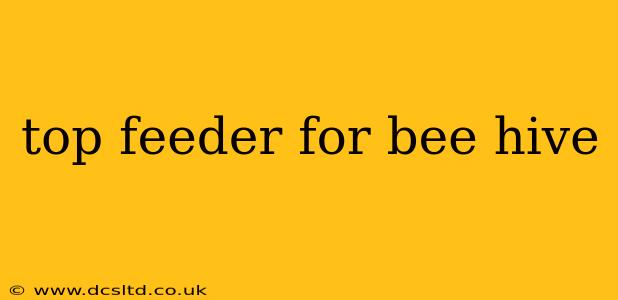Keeping your bees healthy and productive requires providing them with consistent access to food, especially during times of nectar dearth or when establishing a new colony. A top feeder is a popular choice for supplementing your bees' diet, offering several advantages over other feeding methods. But with various designs available, choosing the right top feeder for your hive can be crucial. This comprehensive guide will explore the benefits, drawbacks, and different types of top feeders to help you make an informed decision.
What is a Top Bee Feeder?
A top feeder is an internal bee hive feeder that sits on top of the hive boxes, usually directly under the inner cover. This placement minimizes disturbance to the bees and reduces the risk of robbing by other bees or animals. They typically consist of a reservoir filled with sugar syrup or other bee feed, with some mechanism that allows bees to access the food while preventing drowning.
Why Use a Top Feeder for Your Beehive?
Top feeders offer several key advantages:
- Convenience: They're easy to install and refill, often requiring minimal disruption to the hive.
- Reduced Robbing: The internal placement significantly reduces the risk of robbing, a major concern with external feeders.
- Ease of Monitoring: You can easily observe the bees' feeding activity and the syrup level without opening the hive.
- Minimal Disruption: Bees access the food from above, reducing stress and maintaining the hive's internal temperature and humidity.
- Suitable for Various Hive Types: Many designs are adaptable to different hive sizes and configurations.
What are the Different Types of Top Feeders?
Several top feeder designs cater to different needs and preferences:
Entrance Feeders:
While not strictly "top" feeders, entrance feeders are worth mentioning as they are often considered for supplemental feeding. These are placed at the entrance of the hive, offering easy access for the bees, but are more prone to robbing. They are best suited for smaller feeding needs or when combined with a larger internal feeder.
Frame Feeders:
These feeders are designed to replace a frame within the brood box. They offer a relatively large capacity, but they take up valuable space in the hive and may impede the queen's laying pattern.
Boardman Feeders:
These are simple, shallow feeders that sit directly on top of the frames, usually under a shim or inner cover. They are relatively inexpensive and easy to use but have a smaller capacity than other options. They often require a float to prevent bees from drowning.
Bucket/Jar Feeders:
These are often homemade or adapted from common containers. They provide a significant capacity but may require more work to set up securely and to prevent drowning.
Simple Tray Feeders:
These are shallow trays that sit on top of the frames. They are very straightforward and easy to use but tend to have a smaller capacity. They require a float or some other method to prevent bees from drowning.
What are the Disadvantages of Top Feeders?
While top feeders are widely used and generally effective, some drawbacks should be considered:
- Limited Capacity: Some designs have smaller capacities, requiring more frequent refills.
- Potential for Drowning: Bees can drown if the feeder design doesn't properly prevent access to the syrup.
- Possible Mold Growth: If the syrup isn't consumed quickly, mold growth can become an issue.
- Hive Space: Some designs, like frame feeders, can take up valuable space within the hive.
How to Choose the Right Top Feeder?
The best top feeder for your needs depends on various factors, including:
- Hive size and type: Ensure the feeder is compatible with your hive.
- Colony size: Larger colonies require feeders with greater capacity.
- Climate: Extreme temperatures can affect syrup consistency and feeder efficacy.
- Personal preference: Consider ease of use, cleaning, and maintenance.
How to Prevent Drowning in Top Feeders?
Preventing bees from drowning is crucial. Use floaters, provide ample space for bees to land, or create a maze-like structure to guide the bees towards the syrup. Many commercial top feeders incorporate anti-drowning features.
How Often Should I Refill My Top Feeder?
The frequency of refills depends on the feeder's capacity and your colony's consumption rate. Regularly monitor the syrup level and refill as needed, ideally before it's completely empty.
Can I Use Different Types of Syrup in a Top Feeder?
While sugar syrup is the most common, other bee feed options may be used. However, it is essential to follow the instructions of any feed you choose, and to avoid anything harmful to bees.
By carefully considering these factors and choosing the appropriate top feeder for your beehive, you can ensure your bees have a consistent supply of food, promoting their health and productivity. Remember, regular monitoring and maintenance are key to successful beekeeping.
